From Pain Points to Opportunity Areas
The subtle difference between a knob and a lever.

An unexpected interaction with a familiar object.

At a restaurant in San Mateo, the knob from a stove replaces the toilet flush lever. Each of us who use the toilet that evening come back to the table struck by what an unexpectedly pleasant experience it is to turn the knob.
As a researcher or designer, you are not going get to this surprisingly delightful interaction if you constrain your thinking around the idea of pain points – i.e. what is not working for people. Of course no one is going to buy your company’s toilet if it leaks or doesn’t flush – products need to perform their primary functions reasonably well – and as part of an exploration of user experience it’s necessary to find out whether this is indeed the case. But if you are laser-focused on the question “What’s not working for you?” you’ll miss all sorts of opportunities.
In our research engagements we like to include discussion with people about the things in their lives that are working really well for them – inside and outside the focus areas of the project. By figuring out what’s at the heart of these interactions, we might learn, for example, something about the way a service works that we can apply to the development of a product. Or a person might say “I just love the way the big chunky knobs on my Viking stove feel.” And it might be the transposition of this small finding in an ideation session that helps our client go on and create innovative toilets.
We encourage our clients to move from focusing on pain points to thinking about Opportunity Areas. We use what we learn out in the field to point them in promising directions, with a focus on asking “How can we __________ ?”






